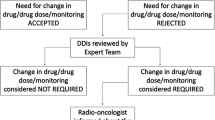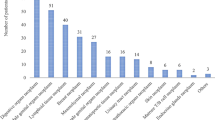Abstract
Objectives
To quantify the frequency of potential drug interactions unrelated to chemotherapy in cancer patients admitted to our institution, and to define risk factors for such interactions.
Methods
Charts of 100 consecutive hospitalized cancer patients were reviewed. Patients receiving chemotherapy and/or hormone therapy were excluded, as were patients admitted for intensive care. Drug–drug interactions were screened with Drug Interaction Facts software, and manually by the authors. Potential interactions were graded by levels of severity (severe, moderate, minor) and significance (one to five, with one representing the highest level of evidence).
Results
The median age of the patients was 67 years, and the length of hospital stay and the number of drugs per patient were 6 days and eight drugs, respectively. In 63 patients 180 potential interactions were detected. Of the potential interactions, 18.3% were severe, 56.7% were moderate, and 25% were minor. Approximately 7%, 18% and 13% of potential interactions were graded as level 1, 2 and 3, respectively. In multivariate analysis, prescriptions with eight or more drugs (P=0.0004) and six or more days of hospital stay (P=0.014) were independent risk factors for potential interactions.
Conclusion
Potential drug interactions are common among hospitalized cancer patients. Length of hospital stay and number of prescribed drugs are risk factors.
Similar content being viewed by others
References
Barrons R (2004) Evaluation of personal digital assistant software for drug interactions. Am J Health Syst Pharm 61:380–385
Beers MH, Storrie M, Lee G (1990) Potential adverse drug interactions in the emergency room. An issue in the quality of care. Ann Intern Med 112:61–64
Bernard S, Bruera E (2000) Drug interactions in palliative care. J Clin Oncol 18:1780–1799
Bjerrum L, Andersen M, Petersen G, Kragstrup J (2003) Exposure to potential drug interactions in primary health care. Scand J Prim Health Care 21:153–158
Buajordet I, Ebbesen J, Erikssen J, Brors O, Hilberg T (2001) Fatal adverse drug events: the paradox of drug treatment. J Intern Med 250:327–341
Carbonin P, Pahor M, Bernabei R, Sgadari A (1991) Is age an independent risk factor of adverse drug reactions in hospitalized medical patients? J Am Geriatr Soc 39:1093–1099
Ciummo PE, Katz NL (1995) Interactions and drug-metabolizing enzymes. Am Pharm NS35:41–51; quiz 51–53
Corcoran ME (1997) Polypharmacy in the older patient with cancer. Cancer Control 4:419–428
Craig C, Stiztel R (1997) Modern pharmacology with clinical application, 5th edn. Little Brown and Company, New York
Daly MP, Lamy PP, Richardson JP (1994) Avoiding polypharmacy and iatrogenesis in the nursing home. Md Med J 43:139–144
Davidson KW, Kahn A, Price RD (1987) Reduction of adverse drug reactions by computerized drug interaction screening. J Fam Pract 25:371–375
Delafuente JC (2003) Understanding and preventing drug interactions in elderly patients. Crit Rev Oncol Hematol 48:133–143
eFacts Online (accessed 2003 May through October) Drug interaction facts. Wolters Kluwer Health. http://www.factsandcomparisons.com
Egger SS, Drewe J, Schlienger RG (2003) Potential drug–drug interactions in the medication of medical patients at hospital discharge. Eur J Clin Pharmacol 58:773–778
Fauno P, Petersen KD, Husted SE (1993) Increased blood loss after preoperative NSAID. Retrospective study of 186 hip arthroplasties. Acta Orthop Scand 64:522–524
Gear RW, Miaskowski C, Heller PH, Paul SM, Gordon NC, Levine JD (1997) Benzodiazepine mediated antagonism of opioid analgesia. Pain 71:25–29
Geppert U, Beindl W, Hawranek T, Hintner H (2003) Drug interactions in clinical practice. A pilot project for quality assurance in prescribing. Hautarzt 54:53–57
Gerson LB, Triadafilopoulos G (2001) Proton pump inhibitors and their drug interactions: an evidence-based approach. Eur J Gastroenterol Hepatol 13:611–616
Glassman PA, Simon B, Belperio P, Lanto A (2002) Improving recognition of drug interactions: benefits and barriers to using automated drug alerts. Med Care 40:1161–1171
Goldberg RM, Mabee J, Mammone M, Chan L, Tarleton G, Broderick S, Robinson DC, Hurst AK, Whelan GP (1994) A comparison of drug interaction software programs: applicability to the emergency department. Ann Emerg Med 24:619–625
Goldberg RM, Mabee J, Chan L, Wong S (1996) Drug–drug and drug–disease interactions in the ED: analysis of a high-risk population. Am J Emerg Med 14:447–450
Hancock D, Kennington JM, Beckner RR, Quick G (1992) Emergency department medication and drug interaction evaluation. Hosp Pharm 27:129–132
Heininger-Rothbucher D, Bischinger S, Ulmer H, Pechlaner C, Speer G, Wiedermann CJ (2001) Incidence and risk of potential adverse drug interactions in the emergency room. Resuscitation 49:283–288
Herr RD, Caravati EM, Tyler LS, Iorg E, Linscott MS (1992) Prospective evaluation of adverse drug interactions in the emergency department. Ann Emerg Med 21:1331–1336
Hosmer DW, Lemeshow S (1989) Applied logistic regression. Wiley, New York
Jankel CA, Martin BC (1992) Evaluation of six computerized drug interaction screening programs. Am J Hosp Pharm 49:1430–1435
Karas S Jr (1981) The potential for drug interactions. Ann Emerg Med 10:627–630
Lackner TE (1991) Interaction of dexamethasone with phenytoin. Pharmacotherapy 11:344–347
McLeod HL (1998) Clinically relevant drug–drug interactions in oncology. Br J Clin Pharmacol 45:539–544
Michocki RJ, Lamy PP, Hooper FJ, Richardson JP (1993) Drug prescribing for the elderly. Arch Fam Med 2:441–444
Pick CG (1997) Antinociceptive interaction between alprazolam and opioids. Brain Res Bull 42:239–243
Poirier TI, Giudici R (1995) Evaluation of drug interaction microcomputer software: an updated comparison. Hosp Pharm 30:888–890, 893–894
Sternbach H (1991) The serotonin syndrome. Am J Psychiatry 148:705–713
Tatro DS (ed) (1997) Drug interaction facts, 4th edn. Facts and Comparisons, St. Louis, MO
Weale AE, Warwick DJ, Durant N, Prothero D (1995) Is there a clinical interaction between low molecular weight heparin and non-steroidal analgesics after total hip replacement? Ann R Coll Surg Engl 77:35–37
Acknowledgements
We thank Dr. Ian Tannock for his editorial help and thoughtful review of the manuscript.
Author information
Authors and Affiliations
Corresponding author
Rights and permissions
About this article
Cite this article
Riechelmann, R.P., Moreira, F., Smaletz, Ò. et al. Potential for drug interactions in hospitalized cancer patients. Cancer Chemother Pharmacol 56, 286–290 (2005). https://doi.org/10.1007/s00280-004-0998-4
Received:
Accepted:
Published:
Issue Date:
DOI: https://doi.org/10.1007/s00280-004-0998-4




